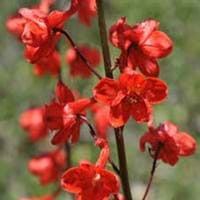Life Span
Annual and Perennial
Perennial
Type
Bulb or Corm or Tuber
Flowering Plants, Ornamental Plants, Shrubs
Origin
Central America, South America
Africa
Types
Vine, Flowering plant
Not Available
Habitat
All sorts of environments, Along Railroads, Banks, Moist Ditches, Roadsides, rocky banks of streams
gardens, meadows
USDA Hardiness Zone
10-13
Not Available
AHS Heat Zone
12-1
12 - 6
Sunset Zone
21,22
Not Available
Habit
Vining/Climbing
Upright/Erect
Flower Color
Purple, Rose
Red, Rose
Flower Color Modifier
Bicolor
Bicolor
Fruit Color
Not Available
Non Fruiting Plant
Leaf Color in Spring
Purple, Dark Green, Black
Green
Leaf Color in Summer
Light Green
Light Green
Leaf Color in Fall
Several shades of Green
Green, Yellow green
Leaf Color in Winter
Light Green
Green, Light Yellow, Tan
Leaf Shape
Acicular
Palmate and toothed
Plant Season
Spring, Summer, Fall, Winter
Spring, Summer, Fall, Winter
Sunlight
Full Sun, Partial Sun
Full Sun, Partial Sun
Growth Rate
Very Fast
Slow
Type of Soil
Clay, Loam, Sand
Clay, Loam, Sand
The pH of Soil
Acidic, Neutral, Alkaline
Acidic, Neutral, Alkaline
Soil Drainage
Well drained
Well drained
Bloom Time
Late Spring, Early Summer, Summer, Late Summer, Early Fall, Fall, Late Fall
Not Available
Tolerances
Drought
Heat And Humidity
Where to Plant?
Container, Ground
Ground, Pot
How to Plant?
Cuttings, Leaf Cutting, Tuber propagation
Seedlings, Stem Cutting
Plant Maintenance
Medium
Medium
Watering Requirements
Keep the Soil well drained, Needs very little water
It cannot sustain wet-feet, Keep ground moist, Requires regular watering, Water more in summer
In Summer
Lots of watering
Lots of watering
In Spring
Moderate
Moderate
In Winter
Average Water
Average Water
Soil pH
Acidic, Neutral, Alkaline
Acidic, Neutral, Alkaline
Soil Type
Clay, Loam, Sand
Clay, Loam, Sand
Soil Drainage Capacity
Well drained
Well drained
Sun Exposure
Full Sun, Partial Sun
Full Sun, Partial Sun
Pruning
Remove damaged leaves, Remove dead branches, Remove dead leaves
Cut away fading foliage, Do not prune during shooting season, Remove damaged leaves, Remove deadheads
Fertilizers
All-Purpose Liquid Fertilizer
High-phosphorous fertilizers used, Organic Flower Fertilizer
Pests and Diseases
Red blotch
Bacterial leaf spot, fungus, Mealybugs
Plant Tolerance
Drought
Heat And Humidity
Flower Petal Number
Single
Single
Foliage Texture
Coarse
Fine
Foliage Sheen
Matte
Matte
Attracts
Aphids, Beetles, Cutworms, Insects, Mites, Whiteflies
Butterflies
Allergy
Abdominal pain, allergic reaction, Nausea, Skin rash, Twitching of face
Severe allergen, Skin irritation, Skin rash, Throat itching, Vomiting
Aesthetic Uses
Not Used For Aesthetic Purpose
Beautification, Borders, Showy Purposes, Used for decorating walls, fences, gates, hedges, etc.
Beauty Benefits
Not Available
No Beauty Benefits
Environmental Uses
Air purification
Air purification
Medicinal Uses
Cures constipation, Fiber, Low calories, lowering blood pressure, Potassium, ß-carotene, Vitamin A, Vitamin C
No Medicinal Use
Part of Plant Used
Leaves, Root, Shoots, Stem, Tuber
Flowers
Other Uses
Starch, Used As Food, Used as Ornamental plant
Used in making blue ink
Used As Indoor Plant
Sometimes
No
Used As Outdoor Plant
Yes
Yes
Garden Design
Container, Edible, Groundcover, Hanging Basket, Herb / Vegetable, Mixed Border, Rock Garden / Wall, Vine
Edging, Feature Plant
Botanical Name
IPOMOEA batatas 'Blackie'
Delphinium cardinale
Common Name
Blackie Sweet Potato Vine, Sweet Potato Vine
Scarlet larkspur, Cardinal larkspur
In Hindi
शकरकन्द
लाल रंग Delphinium
In German
Süßkartoffel
Scarlet Delphinium
In French
Patate douce
Scarlet Delphinium
In Spanish
Ipomoea batatas
Scarlet Delphinium
In Greek
Sweet potato
Scarlet Δελφίνιο
In Portuguese
Batata-doce
Scarlet Delphinium
In Polish
Wilec ziemniaczany
Scarlet Delphinium
In Latin
Ipomoea batatas
Delphinium coccino
Phylum
Tracheophyta
Tracheophyta
Class
Magnoliopsida
Magnoliopsida
Order
Solanales
Ranunculales
Family
Convolvulaceae
Ranunculaceae
Clade
Angiosperms, Asterids, Eudicots
Angiosperms, Eudicots
Tribe
Not Available
Not Available
Subfamily
Not Available
Not Available
Number of Species
Not Available
Importance of Sweet Potato Vine and Scarlet Delphinium
Want to have the most appropriate plant for your garden? You might want to know the importance of Sweet Potato Vine and Scarlet Delphinium. Basically, these two plants vary in many aspects. Compare Sweet Potato Vine and Scarlet Delphinium as they differ in many characteristics such as their life, care, benefits, facts, etc. Every gardener must at least have the slightest clue about the plants he wants to plant in his garden. Compare their benefits, which differ in many ways like facts and uses. The medicinal use of Sweet Potato Vine is Cures constipation, Fiber, Low calories, lowering blood pressure, Potassium, ß-carotene, Vitamin A and Vitamin C whereas of Scarlet Delphinium is No Medicinal Use. Sweet Potato Vine has beauty benefits as follows: Not Available while Scarlet Delphinium has beauty benefits as follows: Not Available.
Compare Facts of Sweet Potato Vine vs Scarlet Delphinium
How to choose the best garden plant for your garden depending upon its facts? Here garden plant comparison will help you to solve this query. Compare the facts of Sweet Potato Vine vs Scarlet Delphinium and know which one to choose. As garden plants have benefits and other uses, allergy is also a major drawback of plants for some people. Allergic reactions of Sweet Potato Vine are Abdominal pain, allergic reaction, Nausea, Skin rash and Twitching of face whereas of Scarlet Delphinium have Severe allergen, Skin irritation, Skin rash, Throat itching and Vomiting respectively. Having a fruit bearing plant in your garden can be a plus point of your garden. Sweet Potato Vine has no showy fruits and Scarlet Delphinium has no showy fruits. Also Sweet Potato Vine is not flowering and Scarlet Delphinium is flowering. You can compare Sweet Potato Vine and Scarlet Delphinium facts and facts of other plants too.





